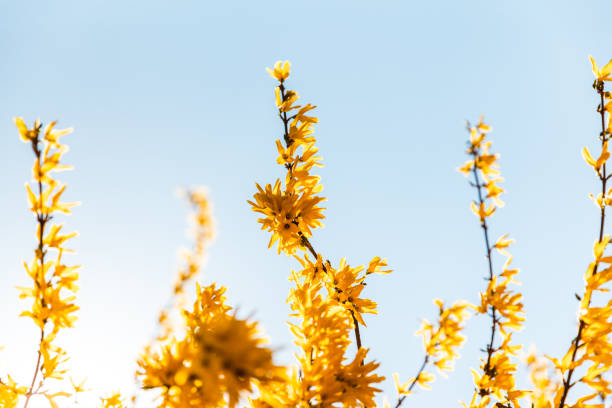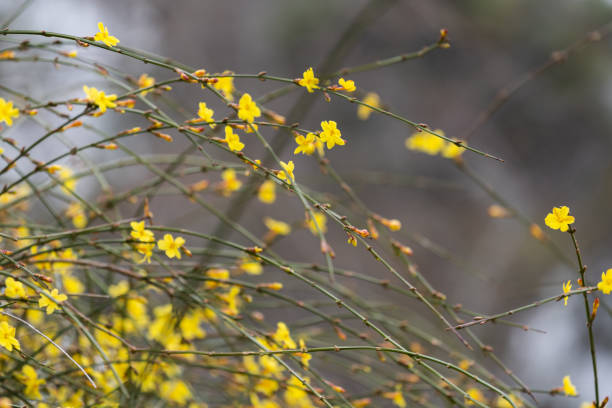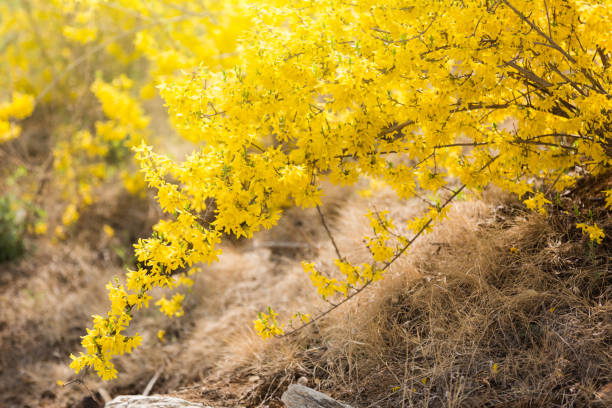Winter Jasmine: When To Plant and How to Grow it!
Fall is the best time to plant because it promotes proper root development. However, it is possible to plant it at other times of the year as long as freezing and extremely hot days are avoided. Winter jasmine prefers to be in the sun or in partial shade, which is necessary to flower. Ensure that your garden soil is well-balanced by incorporating soil mix.

Table of Contents
Winter Jasmine Growing Conditions
Depending on where you live, Winter Jasmine (Jasminum nudiflorum) may be the perfect choice for your cold-weather garden. Before its glossy, green leaves of three leaflets emerge, this deciduous, mounding, or vine-like shrub displays slender, willowy branches and bright yellow flowers. If you decide to use it to cover a steep slope in your landscape or to spill over a wall, it would be fantastic. It has the potential to reduce soil erosion as well.
Fast-growing, this plant can grow up to four feet tall and six to eight feet wide if left unsupported, which is ideal for creating a groundcover if that’s what you’re after. As with any climbing plant, the stems must be properly trained from the start to progress quickly upwards. If not, it will flop about aimlessly. Using a trellis, it can grow up to 15 feet in height.
When it’s a shrub, it forms a four-foot-tall mound with arching branches and roots that spread as it moves along the ground. Even the still-green stems of the plants look stunning in the waning days of winter. Early spring or late winter is a great time to see the showy yellow flowers before turning green.
A well-drained, full-sun location in any type of soil is ideal for winter jasmine to thrive (adding some compost always helps). As a final step before planting, you can gently scratch the ends of the soil ball with your fingernails to turn them outwards. Winter jasmine is perfect for hiding an unsightly fence or for use as a ground cover in shady areas. You might be able to train it to grow on a trellis as an alternative.
Winter jasmine’s rooting at the internodes can make it a weedy plant at times. It can be kept in check with a little trimming.
Even though it is commonly used as an ornamental plant, winter jasmine is not a vine. It is, by nature, a scrambler. This bush will grow right over other bushes if left to its own devices to grow naturally in the wild. It’s also worth noting that each dangling shoot that touches the ground will begin rooting.
As far north as USDA zone 5 or 6, you can grow this hardy variety of jasmine. In a windy area like zone 5, you may want to plant your jasmine close to a building to screen it from the wind.
Growing From Seeds
The seeds of winter jasmine should be sown several months before they are ready to be transplanted into the ground. Sow seeds as soon as they are ready to be sown. Before planting the seeds, soak them for 24 hours in potting soil and then water the soil until it is evenly moistened. To prevent evaporation, place in direct sunlight and cover with plastic wrap. As soon as they have two sets of leaves, you can harden them off for a week outside before planting them in their new garden location. Keep the soil moist.
Make sure to start your winter jasmine seedlings indoors a few months before the date you plan to plant them outside. Soak the seeds for a full day before planting them in the ground. Soak a few small starter cells in potting soil, then plant them after the soil has been allowed to drain completely.

Winter Jasmine Care
Remember that ‘winter jasmine’ is another common name for Jasminum polyanthum for future reference. That, however, is a distinct species of plant. Winter jasmine grows as a shrub with a central clump, sending out long branches that develop into vines. How you treat the plant determines its shape: allow the long stems to spread for a shrubby groundcover. As well as, you can add a trellis and guide the vines up it to grow horizontally. Vine growth can also be directed along fences and arbors. You can see how this Jasmine plant could be a great choice for a planting bed where you need something that gives you blooms. Spreads to fill in an area quickly and requires minimal care. In addition, it looks beautiful when it spills over the side of the wall.
Growing Requirements
- Light-To grows this plant, you’ll need anywhere from full sun to partial shade. In fact, it’s one of the best sun-loving perennial vines.
- Soil-A well-draining soil is essential for the growth of winter jasmine.
- Water-When the top inch of soil feels dry to the touch, water the winter jasmine.
- Humidity and Temperature-USDA hardiness zones 6-10 are suitable for growing winter jasmine. In the winter, it can handle temperatures as low as 5-degrees Fahrenheit.
- Fertilizer-It is not necessary to fertilize the plants frequently. Still, a slow-release fertilizer can be added to the plant’s base if you desire an abundant flower display.
When to Prune
Winter jasmine can be used as a shrub in your yard if you keep it well-pruned. However, as long as you don’t interfere with its natural growth, it will behave like a vine. Both a groundcover and a vine serve two purposes.
It should be supported by a structure, such as a wooden arbor, and the vines should be tied to it. These early bloomers can also be used as ground covers because of their dense foliage. Use them to control erosion in landscaping on slopes, for example. On the other hand, Winter jasmine can be invasive if left alone. This is because they stem from roots wherever they contact the ground. It is essential to prune unsupported plants to keep them from spreading into areas that are not welcome.
To prune these plants once a year, the best time to do so is right after they have bloomed in the spring. Pruning at this time will ensure that you won’t lose any flowers for the following year. Pruning multiple times may be necessary if you want to control the spread of the plant, even if it means fewer flowers for the following year.

Winter Jasmine Propagation
Cuttings from semi-hardwood, cut with clean and sharp gardening shears, can propagate winter jasmine. Plant the cuttings directly into well-draining pots. It also produces new offshoots naturally, with branches that touch the developing ground roots. Simply cut the rooted stem off the main plant and dig up your new seedling from the ground. You either pot the specimen or plant it somewhere else in your landscape as a final step.
Repotting Winter Jasmine
Winter jasmine thrives in pots and should be planted in a mixture of peat and sand that drains well to prevent root rot. It will eventually become pot-bound if left in its original pot for an extended period. As soon as the flowers fade, you should repot your plants.
